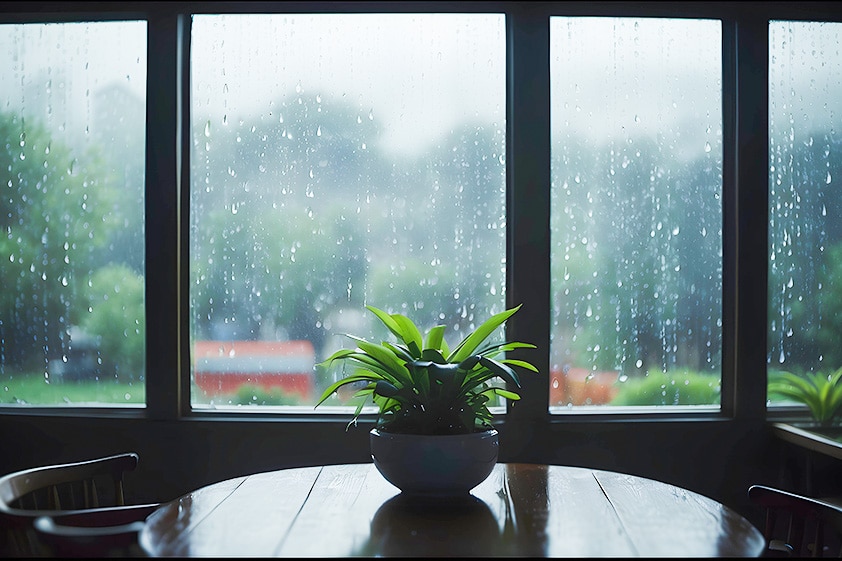
Monsoon seasons bring relief from scorching summers but can also introduce a host of challenges for homeowners. While the rain rejuvenates the environment, it also poses risks to your property, from leaky roofs to damp walls and potential electrical hazards. A well-prepared home can withstand these challenges, ensuring safety and comfort for your family. This article provides a comprehensive guide to monsoon home maintenance, covering essential areas that require attention.
Addressing Interior Vulnerabilities
The interior of your home is just as susceptible to monsoon-related damage as the exterior. Dampness and mold are common problems that arise during the rainy season. Check your walls and ceilings for any signs of moisture or leaks. Address these issues promptly by sealing cracks and using anti-mold treatments to prevent further damage.
If you have wooden furniture or flooring, take extra precautions to protect them from excess humidity. Moisture can cause wood to swell, warp, or even rot. Using dehumidifiers can help maintain optimal indoor humidity levels while placing silica gel packets in closets can prevent mold growth.
Electrical systems also need careful attention during monsoons. Exposed wires or faulty connections can lead to short circuits or electrical fires when they come into contact with water. Ensure that all wiring is properly insulated and schedule a professional inspection to identify and resolve potential hazards.
Reinforcing Doors and Windows
Windows and doors are critical entry points for rainwater if not properly sealed. Check for gaps or cracks around window panes and doorframes. Weatherstripping can be a simple yet effective solution to keep water and humidity out. For sliding windows, ensure the tracks are clean and free of debris that might hinder their operation.
If your windows are fitted with mesh or screens, inspect them for tears or rust. Damaged screens can allow insects to enter your home, particularly during the monsoon season when pests are more active. Installing rain guards or awnings over windows can offer added protection, preventing water from seeping in during heavy downpours.
Preparing Your Home’s Exterior
In monsoon areas such as Arizona, you have to start with the roof. The exterior of your home bears the brunt of monsoon rains, making it crucial to inspect and prepare it beforehand. Start by examining the roof for any damage, cracks, or loose shingles. Even minor issues can lead to leaks, causing significant water damage to your interiors. If you face any major issues, try contacting a roof repair company to ensure the job is handled by professionals. Cleaning out gutters and downspouts is equally important to ensure the efficient drainage of rainwater. Blocked gutters can lead to water pooling around your home, weakening the foundation and inviting pests.
If your home has outdoor furniture, make sure it is adequately protected. Wooden or metal furniture left exposed to rain can degrade quickly. Invest in waterproof covers or move items indoors to shield them from the elements. Additionally, inspect the paint on your home’s exterior walls. Cracks or peeling paint can allow moisture to seep in, causing dampness and mold. Applying a fresh coat of waterproof paint can help safeguard your walls.
Protecting Your Home’s Foundation
The foundation of your home is its backbone, and prolonged exposure to water can weaken it over time. Ensure that the ground around your home slopes away from the foundation to prevent water from pooling. If you notice cracks in the foundation or basement walls, address them immediately to avoid structural issues.
Installing a sump pump in your basement or crawl space can be an effective way to manage water accumulation during heavy rains. Regularly check the pump’s functionality to ensure it is ready for use when needed. Applying waterproofing treatments to your basement walls can also offer added protection against moisture.
Landscaping and Drainage Management
Your home’s landscaping can play a significant role in preventing water-related issues during monsoons. Trim overhanging branches and remove dead trees that could fall during storms, causing damage to your property. Clear debris from your yard to prevent it from clogging drainage systems.
Inspect the drainage around your property to ensure it is effective in channeling water away from your home. Installing French drains or rainwater harvesting systems can help manage excess water while promoting eco-friendly practices. Avoid planting trees or shrubs with invasive root systems near your home, as they can damage underground pipes and drainage systems.
HVAC and Appliance Maintenance
Monsoons can put additional strain on your HVAC systems, especially air conditioners and dehumidifiers. Schedule a professional inspection of your HVAC system to ensure it is functioning efficiently. Cleaning or replacing filters can improve air quality and prevent the spread of allergens, which are often more prevalent during the rainy season.
Appliances such as washing machines and refrigerators should also be checked for any electrical issues. Ensure that all appliances are connected to surge protectors to safeguard them against power fluctuations caused by storms. Avoid running appliances during heavy rain if you suspect electrical instability in your area.
Pest Control Measures
The rainy season creates the perfect environment for pests such as termites, ants, and mosquitoes to thrive. Conduct a thorough inspection of your home for signs of pest infestations, particularly in damp and dark areas. Seal gaps or cracks in walls and floors to block entry points for pests.
Using natural repellents or professional pest control services can help keep your home free of unwanted visitors. For mosquito control, eliminate standing water in and around your home, as it serves as a breeding ground. Installing mosquito nets on windows and using insect-repellent sprays can further enhance protection.
Ensuring Safety and Preparedness
Beyond addressing physical maintenance, being prepared for emergencies is vital during the monsoon season. Keep a basic toolkit handy for minor repairs and ensure that you have flashlights, batteries, and a fully charged power bank in case of power outages.
Create a list of emergency contact numbers, including local electricians, plumbers, and roof repair services, and keep it easily accessible. If you live in a flood-prone area, consider investing in sandbags or flood barriers to protect your home from water intrusion.
Sustainable Solutions for Monsoon Readiness
Incorporating sustainable practices into your monsoon maintenance routine can benefit both your home and the environment. Harvesting rainwater, for instance, is an excellent way to conserve water while preventing waterlogging around your property. Collected rainwater can be used for irrigation or cleaning purposes.
Using eco-friendly paints, sealants, and cleaning agents can reduce your environmental impact while maintaining your home. Opting for energy-efficient appliances and lighting can also contribute to a more sustainable lifestyle during the monsoon season and beyond.
Final Thoughts
A proactive approach to monsoon home maintenance can save you time, money, and stress in the long run. By addressing potential vulnerabilities and implementing preventive measures, you can enjoy the beauty of the rainy season without compromising your home’s safety and comfort. Whether it’s inspecting your roof, safeguarding electrical systems, or managing drainage, each step contributes to a well-prepared home that stands resilient against the challenges of the monsoon.








